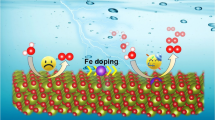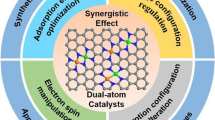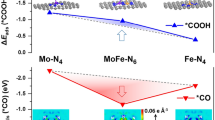Abstract
Herein we study the effect of strain on the catalytic activity of different Pt-doped single wall metallic carbon nanotubes (SWCNT) towards the oxygen reduction reaction (ORR). We consider the possibility of the Pt-doped at single vacancy inside the SWCNT to investigate the effect of confinement on the reaction mechanism. Density functional theory calculations indicate that for the SWCNTs with tube diameters below 7 Å, the strain energy varies significantly influencing the adsorption energies of the key intermediates of the ORR reaction. For the SWCNTs with tube diameters above 7 Å, on the other hand, both the calculated strain and the adsorption energies are almost constant. We furthermore find that the adsorption energies are strongly affected by confinement effects as shown for Pt-doped systems that are located inside the SWCNT. We show that the Pt-doped at single vacancy of the SWCNT strongly binds the oxygenated species under ORR potentials and therefore the active species is covered by oxo- or hydroxo group. Because the presence of Pt atoms doped at the single and double vacancies of the SWCNT is equivalently probable we also studied the Pt-doped at double vacancy. We find that the most active motif is the Pt-doped at double vacancy of SWCNT with 0.24V overpotenital.
Graphical Abstract









Similar content being viewed by others
References
Badwal SPS, Giddey SS, Munnings C, Bhatt AI, Hollenkamp AF (2014) Emerging electrochemical energy conversion and storage technologies. Front Chem 2:79
Wilson MS, Valerio JA, Gottesfeld S (1995) Low platinum loading electrodes for polymer electrolyte fuel cells fabricated using thermoplastic ionomers. Electrochim Acta 40:355–363
Wilson MS, Gottesfeld S (1992) High performance catalyzed membranes of ultra-low Pt loadings for polymer electrolyte fuel cells. J Electrochem Soc 139:L28
Maass S, Finsterwalder F, Frank G, Hartmann R, Merten C (2008) Carbon support oxidation in PEM fuel cell cathodes. J Power Sources 176:444–451
Litster S, McLean G (2004) PEM fuel cell electrodes. J Power Sources 130:61–76
Gan Y, Sun L, Banhart F (2008) One- and two-dimensional diffusion of metal atoms in graphene. Small 4:587–591
Stolbov S, Alcántara Ortigoza M (2015) Gold-doped graphene: a highly stable and active electrocatalysts for the oxygen reduction reaction. J Chem Phys 142:154703
Kaukonen M, Krasheninnikov AV, Kauppinen E, Nieminen RM (2013) Doped graphene as a material for oxygen reduction reaction in hydrogen fuel cells: a computational study. ACS Catal 3:159–165
Park S, Vosguerichian M, Bao Z (2013) A review of fabrication and applications of carbon nanotube film-based flexible electronics. Nanoscale 5:1727–1752
Thostenson ET, Ren Z, Chou T-W (2001) Advances in the science and technology of carbon nanotubes and their composites: a review. Compos Sci Technol 61:1899–1912
Coleman JN, Khan U, Blau WJ, Gun’ko YK (2006) Small but strong: a review of the mechanical properties of carbon nanotube–polymer composites. Carbon N Y 44:1624–1652
Zhang Q, Huang J-Q, Qian W-Z, Zhang Y-Y, Wei F (2013) The road for nanomaterials industry: a review of carbon nanotube production, post-treatment, and bulk applications for composites and energy storage. Small 9:1237–1265
Dai H (2002) Carbon nanotubes: synthesis, integration, and properties. Acc Chem Res 35:1035–1044
Liu X, Pan X, Zhang S, Han X, Bao X (2014) Diffusion of water inside carbon nanotubes studied by pulsed field gradient NMR spectroscopy. Langmuir 30(27):8036–8045
Kresse G (1996) Efficient iterative schemes for ab initio total-energy calculations using a plane-wave basis set. Phys Rev B 54:11169–11186
Kresse G, Furthmüller J (1996) Efficiency of ab-initio total energy calculations for metals and semiconductors using a plane-wave basis set. Comput Mater Sci 6:15–50
Wellendorff J, Lundgaard KT, Møgelhøj A, Petzold V, Landis DD, Nørskov JK, Bligaard T, Jacobsen KW (2012) Density functionals for surface science: exchange-correlation model development with Bayesian error estimation. Phys Rev B 85:235149
Nørskov JK, Rossmeisl J, Logadottir A, Lindqvist L, Kitchin JR, Bligaard T, Jónsson H (2004) Origin of the overpotential for oxygen reduction at a fuel-cell cathode. J Phys Chem B 108:17886–17892
Xin Z, Jianjun Z, Zhong-Can O-Y (2000) Strain energy and Young’s modulus of single-wall carbon nanotubes calculated from electronic energy-band theory. Phys Rev B 62:13692–13696
Kudin KN, Scuseria GE, Yakobson BI (2001) C 2 F, BN, and C nanoshell elasticity from ab initio computations. Phys Rev B 64:235406
Hou Z, Wang X, Ikeda T, Terakura K, Oshima M, Kakimoto M, Miyata S (2012) Interplay between nitrogen dopants and native point defects in graphene. Phys Rev B 85:165439
da Silva LB, Fagan ASB, Mota R (2003) Ab initio study of deformed carbon nanotube sensors for carbon monoxide molecules. Nano Lett 3:1233–1277
Song X, Liu S, Yan H, Gan Z (2009) First-principles study on effects of mechanical deformation on outer surface reactivity of carbon nanotubes. Phys E 41:626–630
Park S, Deepak Srivastava A, Cho K (2003) Generalized chemical reactivity of curved surfaces: carbon nanotubes. Nano Lett 3:1273–1277
Abild-Pedersen F, Greeley J, Studt F, Rossmeisl J, Munter TR, Moses PG, Skúlason E, Bligaard T, Nørskov JK (2007) Scaling properties of adsorption energies for hydrogen-containing molecules on transition-metal surfaces. Phys Rev Lett 99:16105
Fernández EM, Moses PG, Toftelund A, Hansen HA, Martínez JI, Abild-Pedersen F, Kleis J, Hinnemann B, Rossmeisl J, Bligaard T, Nørskov JK (2008) Scaling relationships for adsorption energies on transition metal oxide, sulfide, and nitride surfaces. Angew Chem Int Ed Engl 47:4683–4686
Koper MTM (2013) Theory of multiple proton–electron transfer reactions and its implications for electrocatalysis. Chem Sci 4:2710
Rodríguez-Manzo JA, Cretu O, Banhart F (2010) Trapping of metal atoms in vacancies of carbon nanotubes and graphene. ACS Nano 4:3422–3428
Sun S, Zhang G, Gauquelin N, Chen N, Zhou J, Yang S, Chen W, Meng X, Geng D, Banis MN, Li R, Ye S, Knights S, Botton GA, Sham T-K, Sun X (2013) Single-atom catalysis using Pt/graphene achieved through atomic layer deposition. Sci Rep 3:1775
Yan H, Cheng H, Yi H, Lin Y, Yao T, Wang C, Li J, Wei S, Lu J (2015) Single-atom Pd1/graphene catalyst achieved by atomic layer deposition: remarkable performance in selective hydrogenation of 1,3-butadiene. J Am Chem Soc 137:10484–10487
Jeon I-Y, Choi M, Choi H-J, Jung S-M, Kim M-J, Seo J-M, Bae S-Y, Yoo S, Kim G, Jeong HY, Park N, Baek J-B (2015) Antimony-doped graphene nanoplatelets. Nat Commun 6:7123
Acknowledgements
We gratefully acknowledge support from the U.S. Department of Energy, Office of Sciences, Office of Basic Energy Sciences, to the SUNCAT Center for Interface Science and Catalysis. S.S acknowledges support from the Global Climate Energy Project (GCEP) at Stanford University (Fund No. 52454). The calculations were financially supported by Henan University of Science and Technology (No. 2013ZCX018) and National Natural Science Foundation of China (Nos. U1404212 and 11404098).
Author information
Authors and Affiliations
Corresponding author
Electronic supplementary material
Below is the link to the electronic supplementary material.
Rights and permissions
About this article
Cite this article
Siahrostami, S., Li, GL., Nørskov, J.K. et al. Trends in Adsorption Energies of the Oxygenated Species on Single Platinum Atom Embedded in Carbon Nanotubes. Catal Lett 147, 2689–2696 (2017). https://doi.org/10.1007/s10562-017-2200-8
Received:
Accepted:
Published:
Issue Date:
DOI: https://doi.org/10.1007/s10562-017-2200-8




